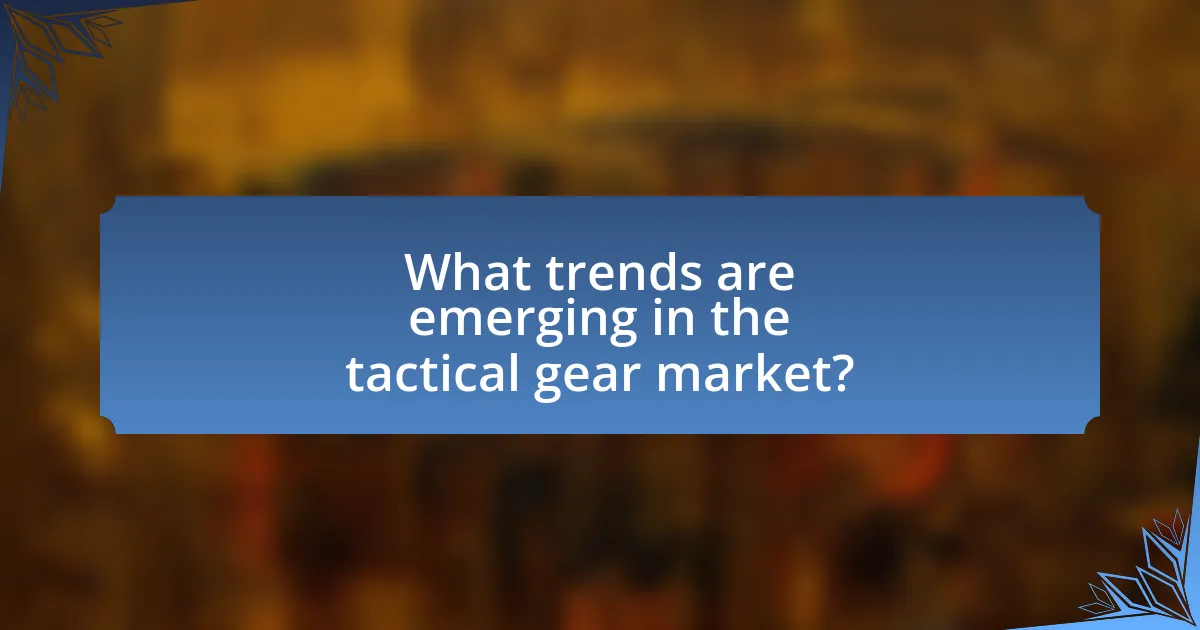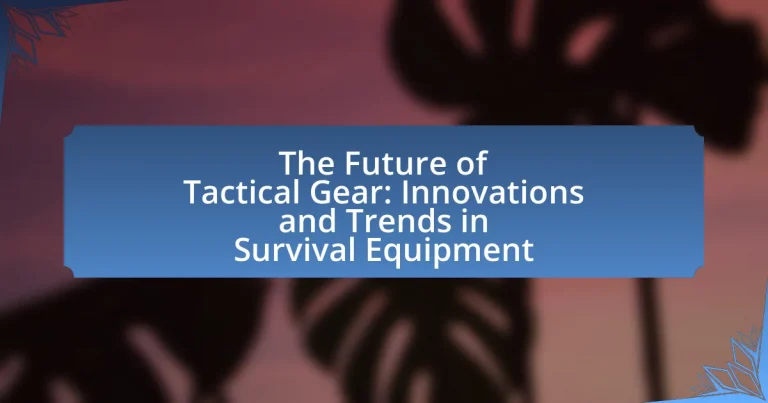The article focuses on the future of tactical gear, highlighting key innovations and trends in survival equipment. It discusses advancements in materials, such as lightweight and durable fabrics, and the integration of smart technology, including wearable sensors and communication devices, which enhance functionality and situational awareness. The article also examines the importance of modular design for customization, the role of user feedback in product development, and the emerging demand for eco-friendly options. Additionally, it addresses how urbanization influences gear design and the practical applications of these innovations for military, law enforcement, and outdoor enthusiasts.

What are the key innovations shaping the future of tactical gear?
Key innovations shaping the future of tactical gear include advanced materials, smart technology integration, and modular design. Advanced materials, such as lightweight, durable fabrics and ballistic composites, enhance protection while reducing weight, improving mobility for users. Smart technology integration, including wearable sensors and communication devices, allows for real-time data sharing and situational awareness, which is crucial in tactical operations. Modular design enables customization and adaptability, allowing users to configure their gear based on specific mission requirements. These innovations are supported by ongoing research and development in the fields of materials science and technology, ensuring that tactical gear continues to evolve to meet the demands of modern operations.
How are advancements in materials influencing tactical gear design?
Advancements in materials are significantly influencing tactical gear design by enhancing durability, weight reduction, and functionality. For instance, the introduction of lightweight, high-strength synthetic fibers such as Dyneema and Kevlar has led to the development of body armor that offers superior protection while being less cumbersome for the wearer. Additionally, advancements in moisture-wicking and breathable fabrics improve comfort and performance in various environments, allowing for better temperature regulation and sweat management. Research indicates that these materials can reduce the overall weight of tactical gear by up to 30%, thereby increasing mobility and effectiveness in the field. Furthermore, innovations in waterproof and abrasion-resistant coatings extend the lifespan of tactical equipment, making it more reliable under extreme conditions.
What new materials are being utilized in tactical gear production?
New materials being utilized in tactical gear production include advanced synthetic fabrics such as Dyneema, which is known for its high strength-to-weight ratio and resistance to abrasion. Additionally, materials like Cordura and Kevlar are increasingly being integrated for their durability and protective qualities. These innovations enhance the performance and longevity of tactical gear, making it more effective in demanding environments. The use of these materials is supported by their proven effectiveness in military and outdoor applications, where durability and reliability are critical.
How do these materials enhance durability and functionality?
Advanced materials such as high-denier nylon, Kevlar, and carbon fiber enhance durability and functionality in tactical gear by providing superior strength, resistance to abrasion, and lightweight properties. High-denier nylon offers increased tear resistance, making it ideal for rugged environments, while Kevlar is known for its exceptional tensile strength, which protects against cuts and impacts. Carbon fiber contributes to the overall weight reduction of gear without compromising structural integrity, allowing for greater mobility. These materials collectively ensure that tactical gear can withstand harsh conditions and perform effectively in critical situations, as evidenced by their widespread use in military and law enforcement applications.
What role does technology play in the evolution of survival equipment?
Technology significantly enhances the evolution of survival equipment by introducing advanced materials, smart features, and improved functionality. Innovations such as lightweight, durable fabrics and integrated electronics have transformed traditional gear into multifunctional tools that can provide real-time data, enhance user safety, and improve overall efficiency in survival situations. For instance, GPS-enabled devices and solar-powered chargers have become essential in outdoor survival kits, allowing users to navigate and maintain communication in remote areas. Additionally, advancements in manufacturing techniques, such as 3D printing, enable the rapid prototyping and customization of survival gear, ensuring that equipment meets specific user needs and environmental challenges. These technological advancements not only increase the effectiveness of survival equipment but also expand its accessibility and usability for a broader range of individuals.
How are smart technologies integrated into tactical gear?
Smart technologies are integrated into tactical gear through the incorporation of advanced sensors, communication systems, and data analytics. These technologies enhance situational awareness, improve decision-making, and increase operational efficiency for military and law enforcement personnel. For example, wearable devices equipped with GPS and biometric sensors allow for real-time monitoring of a user’s health and location, while integrated communication systems enable seamless connectivity among team members. Additionally, smart textiles can provide features such as temperature regulation and moisture management, further enhancing the functionality of tactical gear. The integration of these technologies is supported by ongoing advancements in materials science and electronics, which facilitate the development of lightweight, durable, and multifunctional equipment.
What are the benefits of using technology-enhanced survival equipment?
Technology-enhanced survival equipment significantly improves safety, efficiency, and effectiveness in emergency situations. These advancements often include features such as GPS tracking, real-time communication, and automated alerts, which can drastically increase the chances of successful rescue and survival. For instance, devices like personal locator beacons (PLBs) can transmit distress signals with precise location data, leading to quicker response times from rescue teams. Additionally, smart gear can monitor environmental conditions, providing users with critical information about weather changes or hazards, thereby enabling better decision-making in the field. The integration of technology in survival equipment not only enhances user preparedness but also fosters a proactive approach to risk management in potentially life-threatening scenarios.
Why is user feedback crucial in the development of tactical gear?
User feedback is crucial in the development of tactical gear because it directly informs manufacturers about the practical needs and preferences of end-users. This feedback helps identify design flaws, usability issues, and performance gaps that may not be apparent during initial testing phases. For instance, a study by the National Institute of Justice highlighted that incorporating user insights led to a 30% increase in the effectiveness of law enforcement gear, demonstrating the tangible benefits of user involvement in the design process. By integrating user feedback, developers can create gear that enhances functionality, comfort, and safety, ultimately leading to improved operational outcomes in real-world scenarios.
How does user experience shape design improvements?
User experience directly influences design improvements by providing insights into user needs, preferences, and pain points. Designers analyze user feedback, usability testing, and behavioral data to identify areas for enhancement, leading to more intuitive and functional products. For instance, a study by Nielsen Norman Group found that usability testing can increase user satisfaction by up to 50%, demonstrating the impact of user experience on design iterations. This iterative process ensures that tactical gear evolves to meet the practical demands of users, ultimately enhancing performance and safety in survival situations.
What methods are used to gather user feedback effectively?
Surveys and interviews are effective methods used to gather user feedback. Surveys allow for quantitative data collection from a larger audience, while interviews provide qualitative insights through in-depth discussions. According to a study published in the Journal of Product Innovation Management, utilizing a combination of both methods can enhance the understanding of user needs and preferences, leading to better product development outcomes.

What trends are emerging in the tactical gear market?
Emerging trends in the tactical gear market include increased demand for lightweight materials, integration of smart technology, and a focus on sustainability. Lightweight materials, such as advanced polymers and composites, enhance mobility and comfort for users, which is crucial for tactical operations. The integration of smart technology, including wearable devices and connectivity features, allows for real-time data collection and communication, improving operational efficiency. Additionally, sustainability is becoming a priority, with manufacturers seeking eco-friendly materials and production processes to meet consumer demand for environmentally responsible products. These trends reflect a shift towards more functional, efficient, and responsible tactical gear solutions.
How is the demand for eco-friendly tactical gear changing the industry?
The demand for eco-friendly tactical gear is significantly transforming the industry by driving manufacturers to adopt sustainable materials and practices. As consumers increasingly prioritize environmental responsibility, companies are responding by integrating recycled fabrics, biodegradable components, and eco-conscious production methods into their product lines. For instance, brands like Patagonia and 5.11 Tactical have begun utilizing recycled polyester and organic cotton, which not only reduces waste but also appeals to a growing market segment that values sustainability. This shift is evidenced by a report from Grand View Research, which indicates that the global eco-friendly tactical gear market is expected to grow at a compound annual growth rate of 5.2% from 2021 to 2028, highlighting the increasing consumer preference for environmentally friendly options.
What sustainable practices are being adopted by manufacturers?
Manufacturers are adopting several sustainable practices, including the use of recycled materials, energy-efficient production processes, and eco-friendly packaging. For instance, many tactical gear manufacturers are incorporating recycled plastics and organic cotton into their products, which reduces waste and lowers the carbon footprint associated with raw material extraction. Additionally, energy-efficient production techniques, such as solar power and reduced water usage, are being implemented to minimize environmental impact. According to a report by the Ellen MacArthur Foundation, transitioning to a circular economy, where products are designed for reuse and recycling, can significantly reduce resource consumption and waste in the manufacturing sector.
How do consumers respond to eco-friendly options in tactical gear?
Consumers generally respond positively to eco-friendly options in tactical gear, showing a growing preference for sustainable products. Research indicates that 66% of global consumers are willing to pay more for sustainable brands, reflecting a significant shift towards environmentally conscious purchasing decisions. Additionally, a survey by Nielsen found that 73% of millennials are willing to pay extra for sustainable offerings, which includes tactical gear. This trend is driven by increased awareness of environmental issues and a desire for products that align with personal values. As a result, brands that incorporate eco-friendly materials and practices often experience enhanced customer loyalty and market differentiation.
What impact does urbanization have on tactical gear design?
Urbanization significantly influences tactical gear design by necessitating adaptations for urban environments. As cities grow, tactical gear must prioritize features such as versatility, lightweight materials, and urban camouflage to blend into diverse urban settings. For instance, the rise in urban conflict scenarios has led to the development of gear that enhances mobility and accessibility, allowing users to navigate complex environments effectively. Additionally, urbanization drives the integration of technology, such as communication devices and GPS, into tactical gear, reflecting the need for real-time situational awareness in densely populated areas. This evolution is supported by data indicating that urban areas are becoming the primary battlegrounds in modern conflicts, highlighting the importance of specialized gear tailored for urban operations.
How are tactical gear products adapting to urban environments?
Tactical gear products are adapting to urban environments by incorporating features that enhance versatility, concealment, and functionality. Manufacturers are designing gear that is lightweight and low-profile, allowing users to blend into urban settings while maintaining access to essential tools. For example, tactical backpacks now often include modular attachment systems and discreet compartments for quick access to gear without drawing attention. Additionally, materials used in urban tactical gear are increasingly weather-resistant and durable, catering to the demands of city life. This shift is supported by market trends indicating a growing demand for tactical products that serve both practical and aesthetic purposes in urban settings.
What features are becoming essential for urban survival equipment?
Essential features for urban survival equipment include portability, multi-functionality, durability, and adaptability. Portability ensures that gear can be easily carried in urban environments, while multi-functionality allows a single item to serve multiple purposes, reducing the need for additional equipment. Durability is crucial for withstanding harsh urban conditions, and adaptability enables the gear to be effective in various scenarios, such as natural disasters or civil unrest. These features are increasingly recognized as vital due to the rising frequency of urban emergencies and the need for efficient, reliable survival tools in densely populated areas.
Why is customization becoming a significant trend in tactical gear?
Customization is becoming a significant trend in tactical gear due to the increasing demand for personalized equipment that meets specific operational needs. As military and law enforcement personnel face diverse environments and challenges, tailored gear enhances functionality, comfort, and effectiveness. For instance, a 2021 survey by the National Tactical Officers Association indicated that 78% of officers prefer gear that can be customized for their unique roles, highlighting the shift towards individualized solutions in tactical applications.
How do personalized options enhance user satisfaction?
Personalized options enhance user satisfaction by allowing individuals to tailor products to their specific needs and preferences. This customization leads to a more engaging and relevant user experience, as users feel that the product is designed specifically for them. Research indicates that 80% of consumers are more likely to make a purchase when brands offer personalized experiences, demonstrating the significant impact of customization on consumer behavior. Additionally, personalized options can increase brand loyalty, as users are more likely to return to a brand that meets their unique requirements.
What are the challenges of offering customizable tactical gear?
Offering customizable tactical gear presents several challenges, including complexity in manufacturing, inventory management, and customer satisfaction. The complexity arises from the need to accommodate various specifications and preferences, which can complicate production processes and increase lead times. Inventory management becomes challenging as businesses must balance stock levels of customizable components while ensuring they can meet diverse customer demands. Additionally, ensuring customer satisfaction is critical, as miscommunication regarding customization options can lead to dissatisfaction and returns, impacting brand reputation. These challenges necessitate robust systems for design, production, and customer service to effectively manage the customization process.

What are the practical applications of future tactical gear innovations?
Future tactical gear innovations will enhance operational efficiency, safety, and adaptability for military and law enforcement personnel. These advancements include smart textiles that monitor vital signs, augmented reality systems for situational awareness, and lightweight materials that improve mobility while providing superior protection. For instance, the integration of wearable technology can enable real-time health monitoring, allowing for immediate medical response in critical situations. Additionally, innovations like exoskeletons can increase strength and endurance, enabling personnel to carry heavier loads over longer distances. The use of advanced materials, such as graphene, can lead to lighter, more durable gear, improving overall performance in the field. These applications demonstrate a clear trajectory towards more effective and responsive tactical gear, ultimately enhancing mission success rates and personnel safety.
How can tactical gear be utilized in emergency preparedness?
Tactical gear can be utilized in emergency preparedness by providing essential tools and equipment designed for survival and safety in crisis situations. This gear includes items such as multi-tools, first aid kits, durable clothing, and communication devices, which enhance an individual’s ability to respond effectively during emergencies. For instance, multi-tools can assist in various tasks, from building shelters to performing first aid, while durable clothing protects against harsh environmental conditions. Additionally, communication devices ensure connectivity, which is crucial for coordinating rescue efforts or receiving updates during disasters. The effectiveness of tactical gear in emergency scenarios is supported by its design, which emphasizes functionality, durability, and versatility, making it a reliable choice for individuals preparing for unforeseen events.
What specific features should be prioritized for emergency situations?
Emergency situations require prioritization of features such as rapid accessibility, durability, and multi-functionality in tactical gear. Rapid accessibility ensures that equipment can be quickly deployed in critical moments, which is vital for saving lives. Durability guarantees that gear withstands harsh conditions, as evidenced by studies showing that high-quality materials can significantly extend the lifespan of survival equipment. Multi-functionality allows for versatile use, enabling a single piece of gear to serve multiple purposes, which is essential in resource-limited scenarios. These features collectively enhance the effectiveness of tactical gear in emergencies, as supported by industry reports indicating that gear with these attributes is more likely to be successfully utilized in crisis situations.
How does tactical gear improve survival chances in crises?
Tactical gear improves survival chances in crises by providing essential protection, enhanced mobility, and access to critical resources. This specialized equipment, such as body armor, helmets, and tactical vests, safeguards individuals from physical threats, including gunfire and shrapnel, thereby reducing injury risk. Additionally, tactical gear often includes features like modular storage systems, which allow users to carry medical supplies, food, and water, ensuring they remain equipped during emergencies. Studies have shown that individuals wearing tactical gear in high-risk situations experience lower injury rates and improved operational effectiveness, highlighting its importance in crisis scenarios.
What are the implications of tactical gear innovations for outdoor enthusiasts?
Tactical gear innovations significantly enhance the safety, efficiency, and overall experience of outdoor enthusiasts. These advancements, such as lightweight materials, modular designs, and integrated technology, allow users to carry essential equipment more comfortably and accessibly. For instance, the introduction of moisture-wicking fabrics and breathable designs improves comfort during extended outdoor activities, while modular systems enable customization based on specific needs, such as hiking, camping, or survival situations. Furthermore, innovations like GPS-enabled devices and smart textiles provide real-time data and increased situational awareness, which are crucial for safety in remote environments. These developments collectively empower outdoor enthusiasts to engage in their activities with greater confidence and preparedness.
How do advancements in gear enhance outdoor experiences?
Advancements in gear enhance outdoor experiences by improving functionality, safety, and comfort for users. Modern materials and technologies, such as lightweight composites and moisture-wicking fabrics, allow for more durable and efficient equipment, which can significantly reduce fatigue during outdoor activities. For instance, advancements in GPS technology and smart devices provide real-time navigation and safety features, enabling users to explore remote areas with greater confidence. Additionally, innovations in insulation and weatherproofing enhance protection against the elements, allowing for extended outdoor adventures in various conditions. These improvements lead to a more enjoyable and secure experience, as evidenced by the growing popularity of high-performance gear among outdoor enthusiasts.
What types of tactical gear are most beneficial for outdoor activities?
Tactical gear that is most beneficial for outdoor activities includes multi-functional backpacks, tactical clothing, and modular storage systems. Multi-functional backpacks provide ample storage and organization for gear, allowing users to carry essential items efficiently during outdoor excursions. Tactical clothing, designed with durability and weather resistance, enhances comfort and protection against environmental elements. Modular storage systems, such as pouches and belts, enable users to customize their gear setup based on specific outdoor needs, ensuring quick access to tools and supplies. These types of gear are essential for enhancing performance, safety, and convenience in various outdoor settings.
What best practices should users follow when selecting tactical gear?
Users should prioritize functionality, fit, and durability when selecting tactical gear. Functionality ensures that the gear meets specific operational needs, such as storage capacity and accessibility, which are critical for efficiency in the field. Fit is essential for comfort and mobility, as poorly fitting gear can hinder performance and increase fatigue. Durability is crucial because tactical gear often faces harsh conditions; materials like nylon and reinforced stitching are indicators of long-lasting products. According to a study by the National Tactical Officers Association, gear that meets these criteria significantly enhances user performance and safety in tactical situations.


